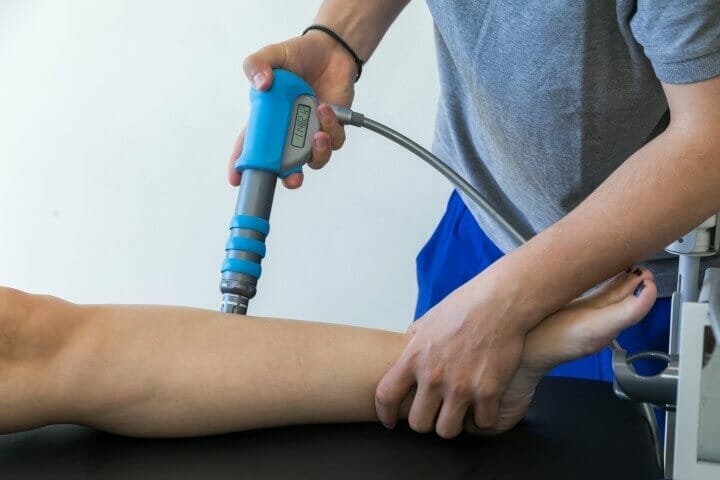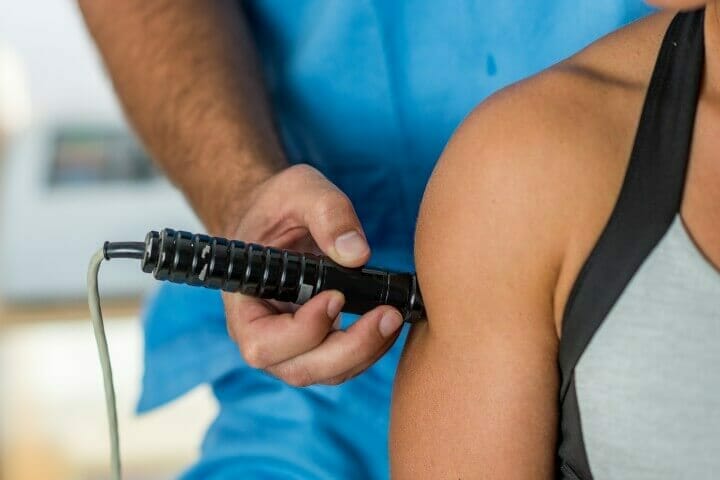Shockwave therapy has become an increasingly popular treatment option for various musculoskeletal conditions, including tendinopathies and chronic pain.
However, many patients may be hesitant to try this therapy due to concerns about pain during the procedure.
The question remains: does shockwave therapy hurt?

Shockwave therapy involves the use of high-energy sound waves to stimulate the body’s natural healing processes.
While the therapy has been shown to be effective in reducing pain and promoting tissue regeneration, some patients may experience discomfort during the procedure.
The level of pain experienced can vary depending on the individual’s pain tolerance and the specific condition being treated.
Despite the potential for discomfort, many patients have reported that the benefits of shockwave therapy outweigh the temporary pain experienced during the procedure.
It is important for patients to discuss any concerns they may have about pain with their healthcare provider before undergoing shockwave therapy.
With proper communication and pain management techniques, patients can feel confident in their decision to try this innovative treatment option.
Understanding Shockwave Therapy

What Is Shockwave Therapy?
Shockwave therapy is a non-invasive medical treatment that uses high-energy acoustic pressure waves to stimulate healing and repair of damaged tissues.
This therapy is used to treat a variety of musculoskeletal conditions, including tendinitis, plantar fasciitis, and tennis elbow.
Types of Shockwave Therapy
There are two types of shockwave therapy: extracorporeal shockwave therapy (ESWT) and radial shockwave therapy.
ESWT uses focused shockwaves that are directed at the affected area, while radial shockwave therapy uses a device that generates acoustic pressure waves that spread out over a larger area.
How Shockwave Therapy Works
Shockwave therapy works by increasing blood flow to the affected area, which stimulates the body’s natural healing process.
The energy from the shockwaves also helps to break up scar tissue and calcifications, which can improve mobility and reduce pain.
During the treatment, the patient may feel a sensation of pressure or discomfort as the shockwaves are applied to the affected area.
However, most patients do not experience significant pain during the procedure.
Conditions Treated with Shockwave Therapy

Shockwave therapy is a non-invasive treatment option for various musculoskeletal conditions. It uses high-energy sound waves to stimulate the body’s natural healing process and promote tissue repair. Here are some of the conditions that can be treated with shockwave therapy.
Musculoskeletal Conditions
Shockwave therapy is effective in treating various musculoskeletal conditions, including plantar fasciitis, tennis elbow, tendinopathy, sports injuries, Achilles tendinopathy, jumper’s knee, and bursitis.
It can also be used to treat patellar tendinitis, a common overuse injury that affects the tendon connecting the kneecap to the shinbone.
Specific Conditions Amenable to Shockwave Therapy
Plantar fasciitis is a condition that causes pain in the heel and bottom of the foot. Shockwave therapy can help reduce pain and inflammation, and improve mobility and function.
Tennis elbow is a type of tendinitis that causes pain in the elbow and forearm. Shockwave therapy can help reduce pain and inflammation, and promote healing of the damaged tissue.
Tendinopathy is a condition that affects the tendons, causing pain and stiffness. Shockwave therapy can help stimulate blood flow to the affected area, promoting healing and reducing pain.
Sports injuries are common among athletes and can range from minor sprains to more severe injuries such as fractures and dislocations. Shockwave therapy can help reduce pain and inflammation, and promote healing of the injured tissue.
Achilles tendinopathy is a condition that affects the Achilles tendon, causing pain and stiffness in the back of the ankle. Shockwave therapy can help reduce pain and inflammation, and promote healing of the damaged tissue.
Jumper’s knee is a condition that affects the patellar tendon, causing pain and stiffness in the knee. Shockwave therapy can help reduce pain and inflammation, and promote healing of the damaged tissue.
Bursitis is a condition that affects the bursae, small fluid-filled sacs that cushion the joints. Shockwave therapy can help reduce pain and inflammation, and promote healing of the damaged tissue.
The Procedure of Shockwave Therapy
Before the Treatment
Before the shockwave therapy treatment, the patient will typically undergo a consultation with the therapist.
During this consultation, the therapist will ask about the patient’s medical history, symptoms, and any previous treatments they have undergone.
The therapist may also perform a physical examination to determine the best course of treatment.
Once the therapist has determined that the patient is a good candidate for shockwave therapy, they will apply a gel to the treatment area. This gel helps to conduct the shockwaves and ensures that they are delivered to the intended area.
During the Treatment
During the shockwave therapy treatment, the therapist will use an applicator to deliver the shockwaves to the treatment area.
The applicator is typically moved over the treatment area in a circular motion. The therapist may adjust the intensity of the shockwaves based on the patient’s comfort level.
The shockwaves themselves may feel uncomfortable or slightly painful, but the therapist will work to ensure that the treatment is as tolerable as possible for the patient.
The length of the treatment session may vary based on the patient’s needs and the severity of their condition.
After the Treatment
After the shockwave therapy treatment, the patient may experience some discomfort or soreness in the treatment area.
This is a normal part of the healing process and should subside within a few days.
The therapist will typically recommend a treatment plan that involves several sessions of shockwave therapy.
This treatment plan may also include other therapies or exercises to help the patient achieve the best possible outcome.
Benefits of Shockwave Therapy
Shockwave therapy is a noninvasive treatment that has been gaining popularity in recent years due to its potential benefits in promoting healing, relieving pain, and improving range of motion.
This treatment uses high-energy sound waves to stimulate the natural healing process of the body, without the need for surgery or medication.
One of the key benefits of shockwave therapy is its ability to promote healing.
The high-energy sound waves used in this treatment can help to increase blood flow and circulation to the affected area, which can in turn help to stimulate the natural healing process of the body.
This can be particularly beneficial for individuals who are recovering from injuries or dealing with chronic pain.
In addition to promoting healing, shockwave therapy can also help to relieve pain.
The high-energy sound waves used in this treatment can help to stimulate the release of pain-relieving chemicals in the body, which can help to reduce discomfort and improve overall quality of life.
This can be particularly beneficial for individuals who are dealing with chronic pain or have limited mobility due to injury or illness.
Another potential benefit of shockwave therapy is its ability to improve range of motion.
By promoting healing and reducing pain, this treatment can help individuals to regain mobility and improve their overall quality of life.
This can be particularly beneficial for individuals who are dealing with conditions that limit their mobility, such as arthritis or other degenerative diseases.
Potential Side Effects and Risks
Shockwave therapy is generally considered safe and effective, but like any medical procedure, it does carry some risks. Patients should be aware of the potential side effects and contraindications before undergoing the treatment.
Common Side Effects
The most common side effects of shockwave therapy include discomfort, bruising, swelling, and numbness in the treated area.
These side effects usually resolve on their own within a few days to a week after treatment.
Patients may also experience mild pain or soreness in the treated area, but this can usually be managed with over-the-counter pain medication.
Serious Risks and Contraindications
While serious complications from shockwave therapy are rare, there are some risks to be aware of.
Infection is a potential risk, although this is uncommon when proper hygiene and sterilization procedures are followed.
Patients with a history of cancer, thrombosis, or pregnancy should not undergo shockwave therapy, as it may exacerbate these conditions.
In addition, shockwave therapy is contraindicated for patients with certain medical conditions, such as pacemakers, blood clotting disorders, and nerve or muscle disorders.
Patients should inform their healthcare provider of any medical conditions or medications they are taking before undergoing shockwave therapy.
Patient Experience and Recovery
Pain and Discomfort Levels
Shockwave therapy is a non-invasive procedure that uses high-energy sound waves to treat various musculoskeletal conditions.
While the therapy is not entirely painless, it is generally well-tolerated by most patients.
The level of discomfort experienced during the procedure varies from person to person, depending on the severity of their condition and their pain threshold.
During the treatment, patients may experience some discomfort or aching sensation in the treated area.
However, the discomfort is usually brief and subsides soon after the treatment.
Some patients may experience mild bruising or swelling in the treated area, which is a normal part of the healing process.
Recovery Timeline
The recovery timeline after shockwave therapy varies depending on the severity of the patient’s condition.
While some patients may experience immediate relief after the first treatment, others may require multiple sessions to achieve the desired results.
Most patients start to feel improvement in their symptoms within a few days of the treatment.
However, it is essential to note that shockwave therapy is not a quick fix, and it takes time for the body to heal and recover fully.
Rehabilitation and Physical Therapy
After the shockwave therapy, patients may need to undergo rehabilitation and physical therapy to improve their range of motion, flexibility, and strength.
The rehabilitation program may include exercises, stretches, and other modalities to help the patient regain their mobility and function.
Physical therapy is an essential part of the recovery process, and patients should follow their therapist’s instructions carefully.
It is crucial to stick to the rehabilitation program to achieve the best possible results and prevent re-injury.
Comparing Shockwave Therapy to Other Treatments
When it comes to treating musculoskeletal pain, there are various options available. Shockwave therapy is one of the non-invasive treatments that have gained popularity in recent years.
In this section, we will compare shockwave therapy to other treatments such as surgery, medication, and steroid injections.
Shockwave Therapy vs. Surgery
Surgery is often considered a last resort for treating musculoskeletal pain. While it can be effective, it also comes with risks and a long recovery period.
Shockwave therapy, on the other hand, is a non-invasive treatment that does not require any incisions. It is also associated with minimal downtime and a low risk of complications.
Shockwave Therapy vs. Medication
Many people turn to medication to manage their pain. However, medication only provides temporary relief and can come with side effects.
Shockwave therapy, on the other hand, addresses the root cause of the pain by promoting healing in the affected area. It is also a drug-free option, which means there are no side effects to worry about.
Shockwave Therapy vs. Steroid Injections
Steroid injections are another common treatment for musculoskeletal pain. While they can provide relief, they also come with risks such as infection and tissue damage.
Shockwave therapy is a non-invasive treatment that does not involve any injections. It is also associated with a lower risk of complications.
Practical Considerations
Cost and Insurance
Shockwave therapy can be a costly treatment option, with prices ranging from $500 to $2,500 per session depending on the location and provider.
Since it is considered an elective procedure, most insurance companies do not cover the cost of treatment. However, some providers may offer financing options or payment plans to make the treatment more affordable.
It is important for patients to check with their insurance provider to see if shockwave therapy is covered under their policy.
Patients should also inquire about any out-of-pocket costs or deductibles that may apply.
Finding a Qualified Provider
When considering shockwave therapy, it is important to find a qualified provider who has experience in the treatment.
Patients should seek out a chiropractor or injury prevention specialist who is licensed and trained in the use of shockwave therapy.
Patients should also ask about the provider’s experience with treating their specific condition and inquire about their treatment plan.
It is important for patients to feel comfortable with their provider and to have confidence in their ability to provide effective treatment.
In addition, patients should research the provider’s reputation and read reviews from previous patients. This can provide valuable insight into the provider’s level of expertise and the effectiveness of their treatment.
Future of Shockwave Therapy
Shockwave therapy has been gaining popularity in recent years as a non-invasive treatment option for various musculoskeletal conditions. With FDA approval for certain indications, shockwave therapy is becoming more widely accepted in the medical community.
Ongoing research in shockwave therapy is focused on improving its efficacy and expanding its indications.
One area of interest is the use of shockwave therapy for tissue regeneration. Studies have shown that shockwave therapy can stimulate the release of growth factors and promote angiogenesis, which may lead to tissue regeneration.
Innovation in shockwave therapy technology is also driving its future.
Newer devices are being developed with improved precision and control, allowing for more targeted treatment. Additionally, advancements in imaging technology are enabling real-time visualization of the treatment area, further enhancing the accuracy of shockwave therapy.
Frequently Asked Questions
Is pain expected during shockwave therapy treatment?
It is common for patients to experience some discomfort during shockwave therapy treatment. However, the level of pain can vary depending on the individual’s pain tolerance and the severity of their condition. The therapist can adjust the intensity of the shockwaves to minimize discomfort.
What is the recovery time following shockwave therapy?
The recovery time following shockwave therapy is typically short. Most patients can resume their daily activities immediately after treatment. However, it is recommended to avoid strenuous physical activity for a few days after treatment.
Can shockwave therapy exacerbate existing pain?
In rare cases, shockwave therapy can exacerbate existing pain. This is more likely to occur if the patient has a pre-existing injury or condition that is aggravated by the treatment. It is important to discuss any concerns with the therapist before undergoing treatment.
Are there any risks of nerve damage from shockwave therapy?
There is a small risk of nerve damage from shockwave therapy, but it is rare. The therapist will take precautions to avoid targeting nerves during treatment, and patients will be monitored for any signs of nerve damage.
How long does discomfort typically last after receiving shockwave therapy?
Discomfort after receiving shockwave therapy is typically short-lived and should subside within a few hours. Some patients may experience mild soreness for a day or two after treatment.
Is it safe to engage in physical exercise after undergoing shockwave therapy?
It is generally safe to engage in physical exercise after undergoing shockwave therapy. However, it is recommended to avoid strenuous activity for a few days after treatment.
The therapist can provide specific recommendations based on the patient’s individual needs and condition.

